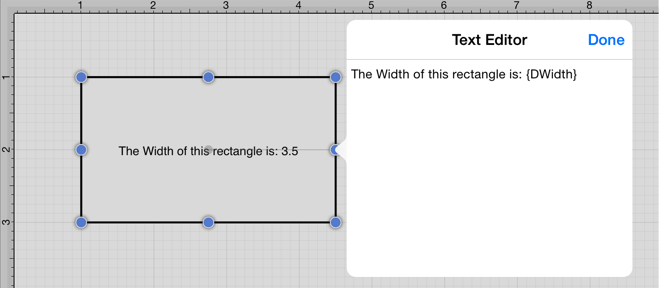Formatting Decimal Variables
The Decimal Variable can be inserted as part of entered text to show the value of another variable in decimal form within the text of a figure. Refer to the Text Variable Table for a list of all supported variables.
Any of the listed pre-formatted numerical variables can have a “D” placed in front of it (as long as they correspond with the type of selected figure) to insert the value as a decimal. The following screenshot shows an example of this:

Both the D and first letter of the entered variable must be capitalized for the value to appear in the selected figure.
By default, the decimal value will be presented with at most 4 digits after the decimal point. An alternative formatting style can be specified by using the {Dxxxx:format} pattern. The table below outlines the options for formatting the decimal value.
| Format Specifier | Name | Description | Examples |
|---|---|---|---|
| 0 | Zero Placeholder | Replaces the zero with the corresponding digit if one is present, otherwise zero appears in the result. | Width = 1234.5678 Variable = {DWidth:00000} Result = 01234 Width = 0.45678 Variable = {DWidth:0.00} Result = 0.46 |
| # | Digit Placeholder | Replaces the pound sign with the corresponding digit if one is present; otherwise, no digit appears in the result string. | Width = 1234.5678 Variable = {DWidth:#####} Result = 1234 Width = 0.45678 Variable = {DWidth:#.##} Result = .46 |
| . | Decimal Point | Determines the location of the decimal separator in the result string. | Width = 0.45678 Variable = {DWidth:0.00} Result (US) = 0.46 Width = 0.45678 Variable = {DWidth:0.00} Result (Germany) = 0,46 |
| , | Group Separator | Inserts a group separator character between each group. | 2147483647 (”# #,#”) = 2,147,483,647 (US) 2147483647 (”# #,#”) = 2.147.483.647 (Estonia) |
| , | Number Scaling | Divides a number by 1000 for specified commas. | 2147483647 (”#,#,,”) = 2,147 (US) 2147483647 (”#,#,,”) = 2.147 (Estonia) |
| % | Percent Placeholder | Multiplies a number by 100 and inserts a localized percentage symbol in the result string. | 0.03697 (”%,#0.00”) = %36.97 (US) 0.03697 (”%,#0.00”) = %36,97 (Greece) 0.03697 (”# #.0%”) = 37.0% (US) 0.03697 (”# #.0%”) = 37,0% (Greece) |
| ‰ | Per Mille Placeholder | Multiplies a number by 1000 and inserts a localized per mille symbol in the result string. | 0.03697 (”# 0.00‰”) = 36.97‰ (US) 0.03697 (”# 0.00‰”) = 36,97‰ (Russia) |
| EO, E+0, E-0, e0, e+0, e-0< | Exponential Notation | Zero - Formats in exponential notation. E/e - Indicates case of the exponent symbol in the resulting string. Plus Sign - Indicates that the sign character precedes the exponent. Minus Sign - Indicates that a sign character precedes only negative exponents. The number of zeros following the E/e symbol determines the minimum number of digits in the exponent (Must have at least one zero). | 987654 (”# 0.0e0”) = 98.8e4 1503.92311 (“0.0 # # e +00”) = 1.504e+03 18901385E-16 (“0.0e +00”) = 1.9e-16 |
| ‘string’, “string” | Literal String Delimiter | Indicates that the enclosed characters should be copied to the result string without changes. | 68 (”# ‘ degrees’”) = 68 degrees 68 (”# ‘ degrees’”) = 68 degrees |
| ; | Section Separator | Defines sections using separate format strings for positive, negative, and zero numbers. | 12.345 (”# 0.0#; (#0.0#); -\0-“) = 12.35 0 (”# 0.0#; (#0.0#); -\0-“) = -0- -12.345 (”# 0.0#; (#0.0#); -\0-“) = (12.35) 12.345 (”# 0.0#; (#0.0#)”) = 12.35 0 (”# 0.0#; (#0.0#)”) = 0.0 -12.345 (”# 0.0#; (#0.0#)”) = (12.35) |
| Other | All Other Characters | The character is copied to the result string unchanged. | 68 (” # °”) = 68 ° |